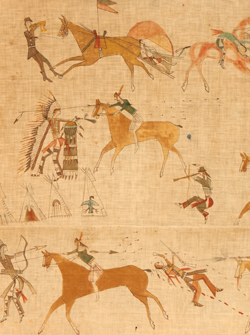
The Helmerich Center for American Research achieved another milestone hosting its first symposium based on its Visiting Scholars Program. Six scholars made presentations related to the theme, “Art and Artistry of Plains Indian Communities” focusing on research recently conducted at Gilcrease.
W. Richard West, M.A., J.D, Autry Museum of the American West, provided a frame of reference for the presentations to follow. He spoke about “The Nature and Meaning of Native Objects from the Viewpoint of a Museum Director,” pointing out that “Native objects occupy a unique ‘middle territory’ between ‘art’ and ‘anthropology’ that is not encompassed fully by either of those Western disciplines standing alone.” He also offered personal insights into the cultural contexts for Native art at Gilcrease.
Emma I. Hansen, M.A., Buffalo Bill Center of the West, spoke on her research of two ledger art books created by Arapaho and Cheyenne Army Scouts at Fort Reno and dated 1879 and 1887. The books record warrior traditions and interactions during a period of rapid cultural change. Through biographical drawings, the artists documented their exploits as warriors and hunters and illustrated family and ceremonial lives.
The pictographic war records of White Swan, a Crow Scout serving with George Armstrong Custer were discussed by Duane King, Ph.D., executive director of the Helmerich Center. A large muslin painting in the collection depicts 11 battle events that recount the military actions of its creator, White Swan (ca. 1852-1904). In all, White Swan created more than three dozen pictographic records on hide, muslin and paper. Of the more than 30 distinct events, half are repeated many times in various paintings. Several illustrations relate to his participation in the Battle of Little Big Horn in 1876. White Swan was severely wounded in the battle leading to permanent disabilities.
David W. Penney, Ph.D., National Museum of the American Indian, spoke on “Sayosapa: Yu’wipi Doctor and Visionary Artist of Fort Peck.” Drawing on various collections (including that of Gilcrease National Board member Jon Stuart), it was pointed out that Sheo Sapa, or Black Prairie Chicken (c. 1840/50 – 1902), a Hunkpapa/ Yanktonai of Poplar River, Fort Peck Agency, Montana, was a powerful Yu’wipi “stone doctor,” who reinvented himself as an artist producing models of his ritual equipment and elaborate paintings on muslin. His life history and the corpus of his work were reviewed as well as an analysis of the issues of misinterpretation that arise when objects are separated from the stories of those who made them.
The 19th-century Plains Indian tobacco bag was examined by Gaylord Torrence, MFA, Nelson-Atkins Museum of Art, as an element of both material culture and artistic expression. Three key topics were explored: the earliest Woodlands antecedents, the stylistic evolution of the containers in the four subregions of the Plains and adjacent Intermontane and the various meanings embodied in the form over time. Items in the Stuart and Gilcrease collections were used for this presentation.
Jennifer McKinney, doctoral candidate, Oklahoma State University, discussed the aftermath of the Dakota War of 1862 and the use of photographs to create a “visual memory” of deception and manipulation. In particular, John Stevens’ panorama commonly referred to as The Sioux War Panorama demonstrates how artistic photographs of the Dakota Indians were used in other art forms to distort and influence the way we remember the past.
Symposium Speakers
Preserving History in the Southern Plains: Arapaho and Cheyenne Ledger Drawings from Fort Reno
Emma Hansen, M.A., Curator Emerita and Senior Scholar, Plains Indian Museum, Buffalo Bill Center of the West
White Swan’s Pictographic War Records from the Battle of Little Big Horn
Duane King, Ph.D., TU Vice President for Museum Affairs and Executive Director of the Helmerich Center for American Research at Gilcrease Museum
Plains Indian Photography in Retrospect: How Visual Culture Influenced Perspectives of Dakota Indians
Jennifer McKinney, M.A., Doctoral Candidate, Oklahoma State University Department of History
Sayosapa: Yu’wipi Doctor and Visionary Artist of Fort Peck
David Penney, Ph.D., Associate Director for Museum Scholarship, National Museum of the American Indian
Plains Indian Tobacco Bags: Containers for the Sacred
Gaylord Torrence, Fred and Virginia Merrill Senior Curator of American Indian Art, The Nelson-Atkins Museum of Art, and Professor Emeritus, Drake University
Personal Reflections on the Layers of Native Art
W. Richard West, (Cheyenne and Arapaho Nation of Oklahoma), Peace Chief of the Southern Cheyenne, Founding Director of the Smithsonian National Museum of the American Indian, President and CEO of the Autry National Center